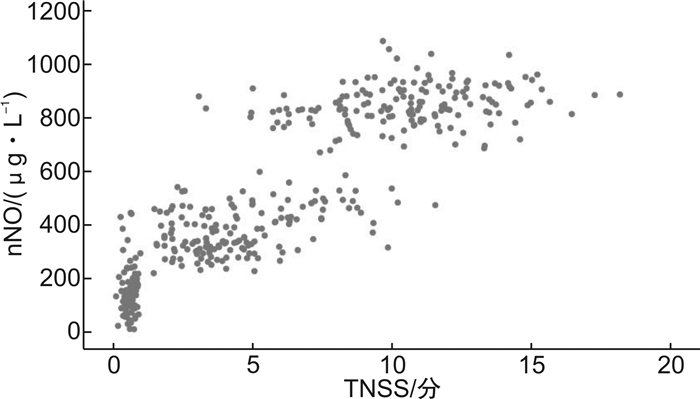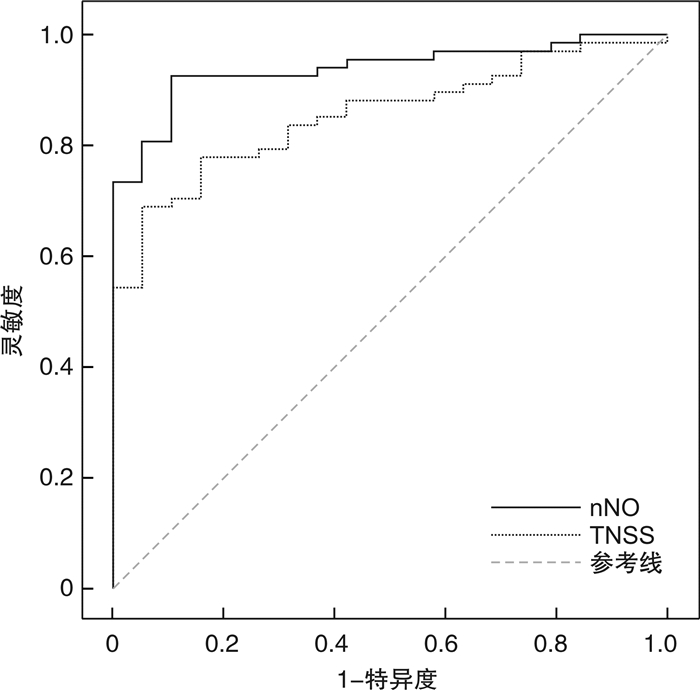Short-term efficacy evaluation of nasal nitric oxide on immunotherapy in children with allergic rhinitis
-
摘要: 目的 初步探讨鼻呼出气NO(nNO)对特异性变应原皮下免疫治疗儿童变应性鼻炎(AR)的短期疗效评估价值。方法 选择2018年1月—2019年1月在广州市妇女儿童医疗中心耳鼻咽喉科治疗的AR患儿87例(病例组)以及同期在医院接受体检的健康儿童80例(对照组)的资料进行回顾性分析。病例组采用特异性变应原皮下免疫治疗方法。对比对照组和病例组不同治疗时间点的nNO及鼻部症状评分(TNSS)变化情况。观察病例组患儿在治疗1年后的治疗效果,分析不同治疗效果的病例组患儿在治疗过程中的nNO与TNSS变化情况(nNO△、TNSS△),测算nNO△、TNSS△对患儿治疗效果的评估价值。结果 病例组的nNO、TNSS均随着治疗时间延长而明显降低(均P < 0.05),病例组在不同治疗时间点的nNO、TNSS均高于对照组(P < 0.05)。对照组和病例组在全部信息采集时间点的nNO与TNSS呈正相关(r=0.870,P < 0.05)。治疗1年后,病例组患儿的治疗有效率为78.16%(68/87)。病例组不同治疗效果患儿的nNO△、TNSS△对比,差异有统计学意义(P < 0.05)。利用nNO△、TNSS△对于患儿的治疗效果推断,最佳截断值为457.78 μg/L、3.95分,约登指数为0.821、0.639。结论 特异性变应原皮下免疫治疗对AR患儿具有良好的治疗效果,利用患儿治疗前后的nNO数值变化对治疗效果进行评估具有良好的价值。Abstract: Objective To evaluate the short-term efficacy of nasal nitric oxide(nNO) on specific allergen subcutaneous immunotherapy in children with allergic rhinitis.Methods The data of 87 children with allergic rhinitis treated in the otolaryngology clinic of Guangzhou Women and Children's Medical Center from January 2018 to January 2019(case group) and 80 healthy children who received physical examination in the hospital during the same time period(control group) were retrospectively analyzed. The case group was treated with specific allergen subcutaneous immunotherapy. Compare the nNO and symptom score changes of the control group and the case group at different time points. Describe the treatment effect of children in the case group after 1 years of treatment. Analyze the changes of nNO and TNSS(nNO△, TNSS△) in the case group of patients with different treatment effects during treatment, and calculate the evaluation value of nNO△and TNSS△on the treatment effect of children.Results The nNO and TNSS in the case group decreased significantly with the prolonged treatment time(both P < 0.05). The nNO and TNSS of the case group at different treatment time points were higher than those of the control group(all P < 0.05). There was a positive correlation between nNO and TNSS in the control group and case group at all information collection time points(r=0.870, P < 0.05). After 1 year of treatment, the effective rate of treatment in the case group was 78.16%(68/87). There was a statistically significant difference in nNO△ and TNSS△ of children with different treatment effects in the case group(P < 0.05). Using the nNO△ and TNSS△ to infer the therapeutic effect of children, the best cut-off values were 457.78 μg/L and 3.95(points). The Youden Index was 0.821, 0.639.Conclusion Specific allergen subcutaneous immunotherapy has a good therapeutic effect on children with allergic rhinitis, and it is of good value to evaluate the therapeutic effect by using the changes of nNO values before and after treatment in children.
-
Key words:
- nasal nitric oxide /
- rhinitis, allergic /
- child /
- subcutaneous immunotherapy
-

-
表 1 对照组和病例组的一般临床资料比较
x±s 组别 例数 性别/例 年龄/岁 身高/cm 体重/kg 病程/月 男 女 对照组 80 41 39 6.87±3.25 117.68±8.14 24.68±5.14 - 病例组 87 42 45 7.25±3.16 120.01±10.37 25.01±6.35 5.25±2.14 统计值 χ2=0.101 t=0.745 t=1.573 t=0.359 - P 0.750 0.457 0.118 0.720 - 表 2 对照组和病例组不同时间点的nNO以及TNSS
x±s 组别 nNO/(μg·L-1 ) TNSS/分 对照组 147.25±61.251)2)3)4) 0.53±0.201)2)3)4) 病例组 治疗前1 d 876.87±76.273)4)5) 11.75±2.723)4)5) 治疗1个月 810.23±62.152)3)4)5) 10.61±2.583)4)5) 治疗6个月 457.25±51.481)2)4)5) 5.28±2.751)2)4)5) 治疗1年 307.66±42.091)2)3)5) 3.65±1.331)2)3)5) F 87.682 69.361 P < 0.001 < 0.001 与病例组治疗前1 d比较,1)P < 0.05;与病例组治疗1个月比较,2)P < 0.05;与病例组治疗6个月比较,3)P < 0.05;与病例组治疗1年比较,4)P < 0.05;与对照组比较,5)P < 0.05。 表 3 病例组不同治疗效果患儿的nNO△、TNSS△对比
x±s 疗效 例数 nNO△/(μg·L-1) TNSS△/分 显效 43 651.72±49.47 9.11±1.15 有效 25 508.25±50.68 6.13±0.87 无效 19 417.25±53.75 3.05±0.76 F - 78.325 59.663 P - < 0.001 < 0.001 表 4 nNO△、TNSS△对患儿治疗效果的评估价值
项目 最佳截断值 ROC曲线下面积 诊断灵敏度/% 诊断特异度/% 约登指数 nNO△ 457.78 0.940 92.65 89.47 82.12 TNSS△ 3.95 0.856 69.12 94.74 63.85 -
[1] 中华耳鼻咽喉头颈外科杂志编辑委员会鼻科组, 中华医学会耳鼻咽喉头颈外科学分会鼻科学组. 变应性鼻炎诊断和治疗指南(2015年, 天津)[J]. 中华耳鼻咽喉头颈外科杂志, 2016, 51(1): 6-24. doi: 10.3760/cma.j.issn.1673-0860.2016.01.004
[2] Fu C H, Tseng H J, Huang C C, et al. Nasal nitric oxide in unilateral sinus disease[J]. PLoS One, 2017, 12(2): e0171965. doi: 10.1371/journal.pone.0171965
[3] 中华耳鼻咽喉头颈外科杂志编委会鼻科组, 中华医学会耳鼻咽喉头颈外科学分会鼻科学组, 小儿学组, 中华儿科杂志编辑委员会. 儿童变应性鼻炎诊断和治疗指南(2010年, 重庆)[J]. 中华耳鼻咽喉头颈外科杂志, 2011, 46(1): 7-8. https://cdmd.cnki.com.cn/Article/CDMD-10611-1014044856.htm
[4] Dweik RA, Boggs PB, Erzurum SC, et al. An Official ATS Clinical Practice Guideline: Interpretation of Exhaled Nitric Oxide Levels(FENO)for Clinical Applications[J]. Am J Respir Crit Care Med, 2011, 184(5): 602-615. doi: 10.1164/rccm.9120-11ST
[5] Juniper EF. Measuring health-related quality of life in rhinitis[J]. Aller Clin Immunol, 1997, 99(2): 742-749. doi: 10.1016/S0091-6749(97)90000-2
[6] 中国过敏性鼻炎研究协作组. 过敏性鼻炎皮下免疫治疗专家共识2015[J]. 中国耳鼻咽喉头颈外科杂志, 2015, 22(8): 379-403. https://www.cnki.com.cn/Article/CJFDTOTAL-EBYT201508001.htm
[7] Bousquet J, Khaltaev N, Cruz AA, et al. World Health Organization; GA(2) LEN; AllerGen. Allergic Rhinitis and its Impact on Asthma(ARIA)2008 update(in collaboration with the World Health Organization, GA(2) LEN and AllerGen)[J]. Allergy, 2008, 63: 8-160.
[8] Zhang Y, Zhang L. Prevalence of allergic rhinitis in China[J]. Allergy Asthma Immunol Res, 2014, 6: 105-107. doi: 10.4168/aair.2014.6.2.105
[9] 胡思洁, 魏萍, 寇巍, 等. 变应性鼻炎患病率及危险因素Meta分析[J]. 临床耳鼻咽喉头颈外科杂志, 2017, 31(19): 1485-1491. https://www.cnki.com.cn/Article/CJFDTOTAL-LCEH201719006.htm
[10] 邱前辉. 变应性鼻炎免疫治疗的现状和未来[J]. 临床耳鼻咽喉头颈外科杂志, 2017, 31(1): 9-12. https://www.cnki.com.cn/Article/CJFDTOTAL-LCEH201701005.htm
[11] Canonica GW, Bousquet J, Casale T, el al. Sublingual immunotherapy: World Allergy Organization Position Paper 2009[J]. Allergy, 2009, 64: l-59.
[12] Cox L, Nelson H, Lockey R, el al. Allergen immunotherapy: a practice parameter third update[J]. J Allergy Clin Immunol, 2011, 127: 1-55. doi: 10.1016/j.jaci.2010.11.027
[13] Zhang L, Wang C, Han D, et al. Comparative study of cluster and conventional immunotherapy schedules with dermatophagoides pteronyssinus in the treatment of persistent allergic rhinitis[J]. Int Arch Allergy Immunol, 2009, 148: 161-169. doi: 10.1159/000155747
[14] Ren L, Zhang W, Zhang Y, et al. Nasal nitric oxide is correlated with nasal patency and nasal symptoms[J]. Allergy Asthma Immunol Res, 2019, 11(3): 367-380. doi: 10.4168/aair.2019.11.3.367
[15] Menou A, Babeanu D, Paruit HN, et al. Normal values of offline exhaled and nasal nitric oxide in healthy children and teens using chemiluminescence[J]. J Breath Res, 2017, 11(3): 036008. doi: 10.1088/1752-7163/aa76ef
[16] You S, Zhang J, Bai Y, et al. Normal values of nasal NO and exhaled NO in young Chinese people aged 9-22 years[J]. World J Otorhinolaryngol Head Neck Surg, 2016, 2(1): 22-27. doi: 10.1016/j.wjorl.2016.02.004
[17] Moilanen E, Vapaatalo H. Nitric oxide in inflammation and immune response[J]. Ann Med, 1995, 27(3): 359-367. doi: 10.3109/07853899509002589
[18] 肖自安, 贺湘波, 伍伟景, 等. 阿罗格变应原皮试及特异性脱敏和变应性鼻炎诊疗中的意义[J]. 中国耳鼻咽喉颅底外科杂志, 2007, 13(3): 212-215. doi: 10.3969/j.issn.1007-1520.2007.03.015
[19] 王桂香, 王蓬鹏, 唐力行, 等. 变应性鼻炎儿童鼻呼出气NO浓度测定方法初探[J]. 山东大学耳鼻喉眼学报, 2016, 30(1): 14-16. https://www.cnki.com.cn/Article/CJFDTOTAL-SDYU201601004.htm
[20] 李依寒, 宋盼盼, 俞晨杰, 等. 变应性鼻炎和支气管哮喘口鼻呼出气NO的相关性研究[J]. 中国眼耳鼻喉科杂志, 2021, 21(2): 86-90. https://www.cnki.com.cn/Article/CJFDTOTAL-YRBH202102003.htm
[21] Hou J, Lou H, Wang Y, et al. Nasal ventilation is an important factor in evaluating the diagnostic value of nasal nitric oxide in allergic rhinitis[J]. Int Forum Allergy Rhinol, 2018, 8(6): 686-694. doi: 10.1002/alr.22087
[22] 胡娟, 何健, 卫旭东, 等. 鼻呼气NO检测在鼻部疾病的应用及进展[J]. 国际耳鼻咽喉头颈外科杂志, 2020, 44(2): 117-120. doi: 10.3760/cma.j.issn.1673-4106.2020.02.012
[23] Piacentini GL, Bodini A, Peroni DG, et al. Nasal nitric oxide levels in healthy pre-school children[J]. Pediatr Allergy Immunol, 2010, 21(8): 1139-1145. doi: 10.1111/j.1399-3038.2010.00989.x
[24] 白银, 尤少华, 张静, 等. 鼻腔呼出气NO无创检测及其临床意义[J]. 中华耳鼻咽喉头颈外科杂志, 2014, 49(4): 341-346. doi: 10.3760/cma.j.issn.1673-0860.2014.04.018
-





 下载:
下载:
